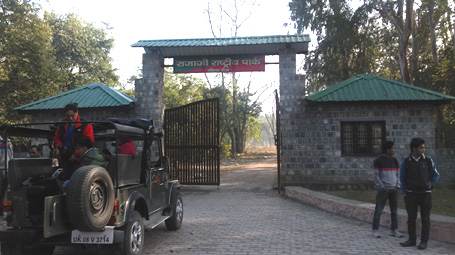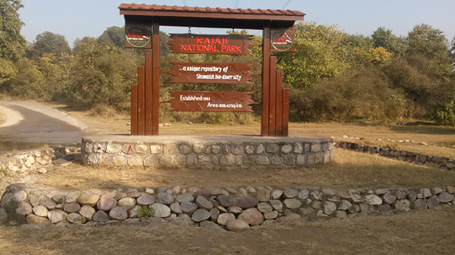About Rajaji Tiger Reserve
Rajaji Tiger Reserve [formerly
known as Rajaji National Park] is distinct for its pristine
scenic beauty and rich bio-diversity. A paradise for nature
lovers and wildlife enthusiasts. Three sancturies in the
Uttaranchal, Shivaliks - Rajaji, Motichur and Chila were
amalgamated into a large protected area and named Rajaji
National Park in the year 1983 after the famous freedom fighter
Late Sri C. Rajgopalachari; popularly known as "Rajaji".
Spread over an area of 820.42 sq km, Rajaji is a magnificient
ecosystem nestled in the Shivalik ranges and the beginning of
the vast Indo-Gangetic plains, thus representing vegetation of
several distinct zones and forest types.


Rajaji is thickly foliated predominantly by the Sal Forest and a
number of other forest types which include the Western Gangetic
Moist and Northern dry Deciduous and Khair-Sissoo forests. Low
Alluvial Savannah Woodlands cover the drier southern margins of
the park, in contrast to the Shiwalik Chir-Pine on the high
reaches of the hills.
The under-wood is light and often absent, consisting of Rohini (Malollotus
philippinensis), Amaltas (Cassia fistula),Shisham ( Dalbergia
sissoo), Sal ( Shorea robusta) , Palash ( Butea monosperma )
,Arjun ( Terminalia arjuna ) Khair ( Acacia catechu ) Baans (
Dendrocalamus strictus ), Semul ( Bombax ceiba ) Sandan (Ougeinia
Oojeinensis), Chamaror, (Ehretia laevis), Aonla (Emblica
officinalis), Kachnar (Bauhienia variegata), Ber (Ziziphus
mauritiana), Chilla (Casearia tomentosa), Bel (Aegle Marmelos),
etc.
Possessing as many as 23 species of mammals and 400 bird
species, the Rajaji Tiger Reserve is home to the Cheetal,
Barking deer, Sambar deer, Wild Boar, antelopes such as the
Nilgai, Goral and of course the Asian Elephant.


The park also protects carnivores such as the Royal Bengal
Tiger, the Leopard and the lesser carnivores like the Jackal,
Hyena, Jungle Cat, Leopard Cat, Civets, Himalayan
Yellow-Throated Marten Himalayan Black and Sloth Bears. At
present there are 14 tigers and around 85 leopards. The primates
include the Rhesus Macaque and the Hanuman Langur. The Indian
Hare and the Indian Porcupine are among some of the small
mammals found in the Reserve.
Reptiles in Rajaji include one of the largest Pythons, King
Cobra, Common Krait, Indian Cobra and the Monitor Lizard. The
Oriental Pied Hornbill, Crested Kingfisher and Crimson sunbird
are some of the residents of the Reserve.
The abundance of nature's bounties heaped in and around this
park, are bound to attract a large number of wildlife
conservationalists, nature lovers and eco-friends to visit this
most breathtaking wilderness area.